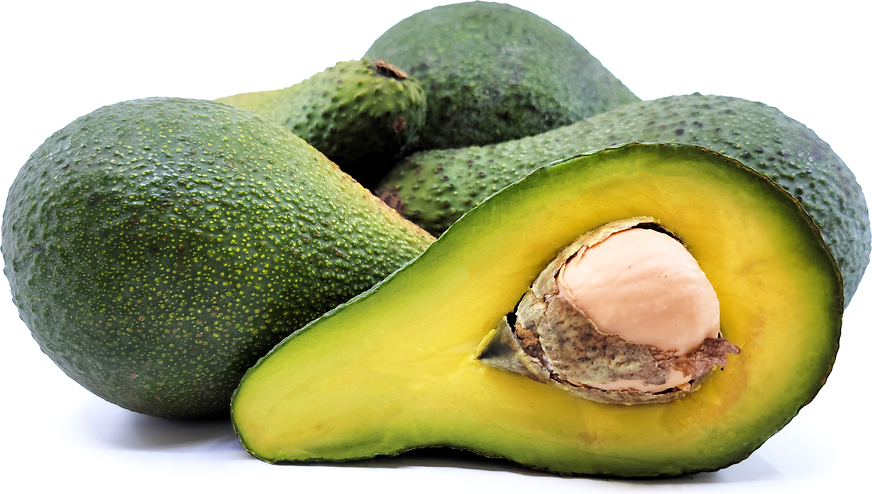


MacArthur Avocados
Estimated Inventory, lb : 0
Description/Taste
MacArthur avocados are large fruits, averaging 12 to 15 centimeters in length, and have a pyriform shape with a bulbous base, tapering to a small and slender, curved neck. The skin is semi-rough with a pebbled, bumpy texture and matures to dark green with some brown discoloration. The skin is also very thin, matte, and pliable, causing the fruit to be easily damaged or punctured. Underneath the surface, the flesh is bright green below the skin, transitioning into a yellow-green hue closer to the seed, and has a smooth, oily, soft, and fibreless consistency. The central seed is firm, hard, and tan with a bumpy surface, encased in a papery and brittle, dark brown layer that frequently sticks to the flesh when opened. MacArthur avocados have a silky and creamy texture with a mild, subtly sweet, and nutty flavor.
Seasons/Availability
MacArthur avocados are available in the late fall through winter.
Current Facts
MacArthur avocados, botanically classified as Persea americana, are a specialty variety belonging to the Lauraceae family. The sweet and nutty fruits were discovered in Monrovia, California, in the early 20th century and are primarily cultivated as a local, Californian variety. MacArthur avocados are favored for their large size and smooth, silky flesh, but the fruits are only produced on a small scale due to their thin, easily punctured skin. The cultivar can be found through avocado growers in San Diego, Los Angeles, and Santa Barbara and is also a favorite home garden variety. Avocado enthusiasts cultivate the variety for the tree’s prolific yields, fast-growing nature, and large fruits, and the trees are also resistant to cold temperatures, allowing them to be suitable for growth in coastal California regions.
Nutritional Value
MacArthur avocados are a good source of pantothenic acid, a B vitamin that helps the body create energy by converting food into usable sugars. The fruits also contain high amounts of vitamin K to assist in wound healing, folate to stimulate the metabolism, copper to maintain healthy nerve functioning, and provide lower amounts of fiber, vitamins C, E, and K, potassium, manganese, and iron.
Applications
MacArthur avocados are best suited for fresh preparations as the soft flesh and subtle flavor is showcased when consumed straight, out-of-hand. The flesh can be removed from the skin and mashed into guacamole or salsa, or it can be sliced and tossed into green salads, cut and used as a topping over soup, or smashed and spread onto toast. MacArthur avocados can also be layered into sandwiches, rolled into sushi, blended into smoothies, used as a thickener in vinaigrettes, or incorporated into hummus. In addition to savory preparations, MacArthur avocados can be utilized in baked goods, including brownies, bread, and cakes, or used to flavor ice cream. MacArthur avocados pair well with spices such as paprika, cumin, nutmeg, and cayenne pepper, herbs such as coriander, mint, cilantro, and dill, balsamic vinegar, cheeses such as feta, goat, and mozzarella, and fruits such as banana, citrus, and pineapple. Whole, unopened MacArthur avocados will ripen in 3 to 7 days when stored on the counter. Once ripe, the fruits should be immediately consumed or stored in the refrigerator for an additional 2 to 3 days.
Ethnic/Cultural Info
MacArthur avocados were named after Thomas H. Shedden’s mother, Elizabeth T. MacArthur. Elizabeth MacArthur lived with Shedden at his property in Monrovia and supported her son’s dream of commercialized avocado expansion. MacArthur lived to be ninety-five, and legend has it that she ate MacArthur avocados daily in the last ten years of her life, allowing her to live a longer, healthy life. It is reported that Shedden often mentioned this legend to both consumers and other growers when discussing the variety to draw attention to avocados being the next superfood.
Geography/History
MacArthur avocados were bred by grower Thomas H. Shedden in his Monrovia, California orchard in 1922. Shedden was initially a businessman, working in the hotel industry. During his time at a hotel, Shedden had the opportunity to sample an avocado, which was a rare fruit at the time, and loved the fruit so much that he decided to switch careers in order to commercialize avocados. Shedden purchased the Florimel Avocado Orchard in Monrovia, California, in 1914 and was selected by the United States Department of Agriculture to receive budwood of new varieties being introduced into California. The budwood was sent from Mexico and Central America and was discovered by Plant Explorer Wilson Popenoe. In 1917, Shedden was elected as the President of the California Avocado Association, and even though his orchard suffered many years of financial loss, Shedden continued to cultivate both exotic and local avocado varieties. MacArthur avocados were Shedden’s most famous introduction, released in 1922, but the origins and parentage of the variety are unknown beyond being discovered in Shedden’s orchard. Today Macarthur avocados can be found through select growers in Southern California and the Santa Barbara region and are primarily sold through local farmer’s markets and specialty grocers. The variety is also grown on a small scale in Queensland, Australia.
Recipe Ideas
Recipes that include MacArthur Avocados. One
| All Recipes |
|
Guacamole |
| Cookie and Kate |
|
Avocado Toast |
| Cafe Delites |
|
Caprese Stuffed Avocado |
| Damn Delicious |
|
Avocado Pasta |
| Cooking Classy |
|
Avocado Salad |




